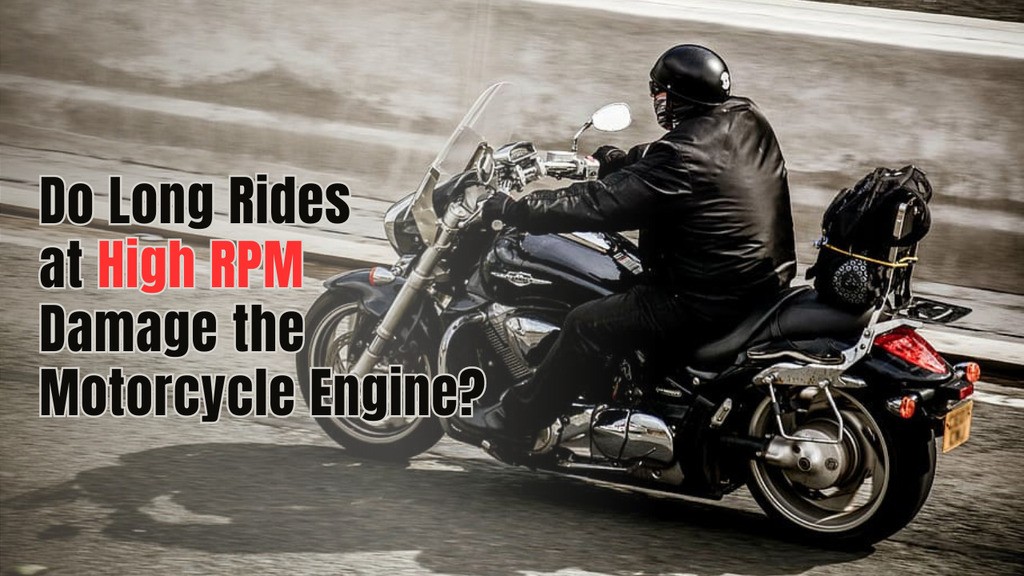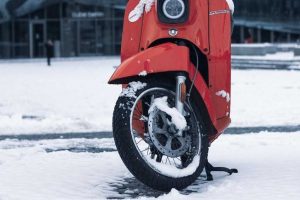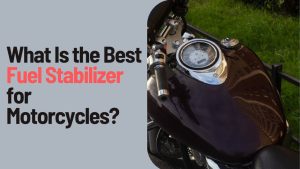As an Amazon Associate, we earn from qualifying purchases. So, the posts in our website may contain affiliate links. We may get a commission when you purchase through our links, at no extra cost to you.
Ever wondered if all those highway miles at high RPM are putting undue stress on your engine? You’re not alone – many riders find themselves cruising at 7000+ RPM on long trips. But do long rides at high RPM damage the motorcycle engine?
Let’s dive into some real-world examples and maintenance tips from experienced owners.
KEY POINTS
- Riding at high RPMs long-term increases engine wear through heat and vibration.
- Engine design factors like cooling systems and components affect durability at high RPM.
- Race-optimized engines are built to withstand high RPM but require frequent rebuilds.
- Street bikes have lower redlines for longer life if not constantly at high RPM.
- Using high-quality synthetic oil and following maintenance is important.
Do Long Rides at High RPM Damage the Engine?
So what exactly goes wrong under the hood when we ride like our hair’s on fire? A few things come to mind.
- Increased wear of internal engine parts
- Accelerated degradation of lubricating oil
- Possible overheating issues
When those pistons are singing at 8 grand, they’re slinging up and down like the clappers. All that rapid cycling is no joke – it really hammers those poor internals over time. Ask any engine builder what kills blocks eventually, and they’ll say extreme piston slap. Go too hard for too long and you’ll need more than just rings and bearings.
The lube takes a beating too. Think about it, at crazy RPM even full-syn gets thinned out pretty quick. No more heavy lubricating films between components. One veteran racer said he changes oil every 20 hours on the track instead of mileage. For us highway heroes, checking it often for metal is smart if you’re a rev junkie.
Excess heat is the silent killer too. We’ve all seen bikes spewing steam, but it’s the unseen simmer that causes the most trouble. Without airflow, things get sticky real fast under the fairings.
Moral of the story? Give your engine some love. Keep her cool, (engines and relationships alike), change fluids often and don’t flog her 24/7. She’ll reward you with years more thrill rides.
SEE MORE: Motorcycle Carb Leaking Gas: Reasons and Fixes
What RPM is Considered “High” for Different Types of Motorcycles?
So we know revving it out isn’t always a no-no. But what counts as “high” can vary on your ride.
On the big luxury tourers like a Gold Wing or FJR, 5k RPM would get the neighbors gossiping! Those huge twins are happy pottering around town in the low end.
If you ride a standard like an old SV650 or a naked beast, 6.5k normally has you in the meat of the powerband. Any higher and longer gets risky though; I knew one SV owner who blew his engine pushing 7500 RPM constantly.
Sportbikes are a different animal. Most of us are itching for VTEC to kick in by 8 grand! But sustaining 9 or 10k is race track territory. For example, a CBR600 won’t like long stints over 11k.
Supersports take the cake – a liter bike pulling 12s just to cruise down the highway! But they need serious love if ridden that way for hours on end.
Moral is know what’s normal for your steed. A little eye-widening here and there won’t fry anything. But don’t try turning your comfy cruiser into a track missile at 6k RPM daily!
| Motorcycle Type | Typical RPM Range | Considered High RPM |
|---|---|---|
| Cruiser | 2,000 – 4,000 RPM | Over 5,000 RPM |
| Standard/Naked Bike | 3,000 – 6,000 RPM | Over 6,500 RPM |
| Sport Bike | 6,000 – 9,000 RPM | Over 8,000 RPM |
| Supersport | 8,000 – 12,000 RPM | Over 10,000 RPM |
| Dual Sport | 3,000 – 6,000 RPM | Over 6,500 RPM |
| Supermoto | 5,000 – 8,000 RPM | Over 7,000 RPM |
| Adventure Tourer | 3,000 – 6,000 RPM | Over 6,500 RPM |
| Dirt Bike | 5,000 – 9,000 RPM | Over 8,000 RPM off-road |
| Scooter | 3,000 – 6,000 RPM | Over 6,500 RPM |
| Harley Davidson | 2,000 – 5,000 RPM | Over 5,500 RPM |
NOTES:
- Cruisers and touring bikes have lower optimal RPM ranges
- Sport bikes and supersports produce peak power at higher RPM
- Off-road, dirt bikes can safely rev higher than street bikes
Mitigating High RPM Risks Through Bike Engine Design
Lucky for us gearheads, engine tech has come a long way. Those mad scientists in the labs sure know how to build motors that can really rev it out without self-destructing.
Take a Superbike motor for instance. Things like lightweight forged pistons, nitride-coated surfaces, oil squirters and bug-sized jet nozzles keep temps in check even banging off the rev limiter lap after lap.
And don’t get me started on gear-driven cams and pressurized oiling! No wonder race rebuilds are the norm after a day at the track.
For us street jockeys, newer bikes have trickled some of this magic down. My buddy’s R6 seems immortal, even after him flogging it to the stars on our morning rides. High-compression and a crossplane crank probably help there.
Material science lets us use less oil too. Esters and PAO synthetics are game-changers. One racer once said to me that Motul Racing Oil flew through 100-mile days without any drama, unlike the Sinclair Dino juice. I’ve also heard good things about Ester-based offerings like Motul 8100 X-clean.
So while normal engines have limits, clever designs and lubes mean ours can handle more flogging without self-destructing. Just thank the tech every time you wring her out!
Maintenance Practices for High RPM Damage Control
- Using high-quality lubricants and changing regularly
- Strictly following maintenance schedule
- Monitoring for signs of unusual wear
If you wanna keep riding hard, some TLC is a must. Those engine gurus know prevention is better than a full rebuild!
Oil is living close to the metal, so good lubricant is insurance. Lots swear by name brand synthetics, changing regularly if you’re a hooligan. For us daily riders, staying on top of the manufacturer change interval helps too.
Check your manual for other maintenance minders. Valve lash gets noisy real quick if you leave it unchecked for too long. One friend ignored this on his CBR, now it sounds like an old typewriter during our rides! Timing belts need swapping too to avoid that failure sound we all fear.
Keep an ear out for anything amiss. Rattles could mean something’s working loose from those high rev sessions. Coolant changes and rad flushes also stave off overheating gremlins, which really fry an engine.
With modern bikes being so reliable, it’s easy to get lazy. But keeping girl well-oiled and maintained is how you both stay happy – and out riding instead of wrenching roadside!
SEE MORE: Everything About Motorcycle Carburetor Choke Cleaning
General guidelines for riders
- Understanding redline limits and max power bands
- Avoiding prolonged periods at very high RPM
- Allowing engines to cool periodically during long rides
Alright boys and girls, time for some common-sense commandments to keep your steed hauling for years to come.
First up, know what your bike can handle. Check the manual for redline. One buddy replaced his GSXR rods after bouncing it off 13K constantly. Ours are street bikes, so an occasional blaze is fine but don’t live there!
Speaking of, taking it easy sometimes also means cooling down periodically on long hauls. We’ve all seen bikes with warped heads from never letting off the boil. Five minutes at a lower RPM works wonders to blow out the heat.
While you’re at it, feel out where the meat of your motor is. Most bikes make peak power somewhere below redline, so stick to there for normal riding versus wide-open-throttle. My FZ hits top torque around 8 anyway.
Always be listening too. Any funny clanks could save you future repairs before they’re major. Pull over to check if concerned – better than dumping cash at the shop later!
FAQs: Do Long Rides at High RPM Damage the Motorcycle Engine?
I ride long distances on the highway regularly. How often can I rev my engine high without damage?
Occasional high rpm riding is fine for most engines, but prolonged periods should be avoided. Try to keep prolonged high rpm stints under 30 minutes. Give your engine a break every 2 hours or so to cool down. Listen for any changes in sound and check oil regularly.
I use my bike for daily commuting which involves a lot of stop and go. Is this bad for the engine?
Normal daily commuting isn’t harsh on engines. Frequent short rides may cause more carbon buildup but aren’t damaging. The key is avoiding prolonged periods at high idle RPMs in stop-and-go traffic.
How often should I change my oil if I regularly ride at high RPM?
If riding at high RPM frequently, change your oil more often than the standard interval – every 3,000-4,000 miles is a good guideline. Use a high-quality synthetic oil rated for severe service. Frequent oil changes are important to remove heat and contaminants.
What signs would indicate my engine is being damaged from high RPM riding?
Listen for new knocking/ticking sounds, roughness, or vibrations. Check for metal flakes in the oil. Feel for abnormal engine heat. Catching issues early lets you address problems before catastrophic damage occurs. Don’t ignore any changes in engine behavior.




